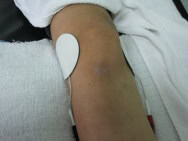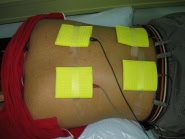Electrotherapy is a drug free, non-invasive and non-addictive treatment option. The use of electrical current in this modality of treatment may surprise you but you can rest be assured that it is safe and has been in use since 1855. Electrotherapy delivers small, pulsating current to muscles and nerve endings. This current causes repeated muscle contraction and relaxation. Such stimulation allows the involved muscles to strengthen, relax and thus relieves pain.
Thereupetic uses of electrotherapy
- Pain management
- Treatment of neuromuscular dysfunction
- Improvement of strength
- Improvement of motor control
- Retards muscle atrophy
- Improves local blood circulation
- Improves range of joint mobility
- Induces repeated stretching of contracted soft tissues
- Induces repeated stretching of contracted soft tissues
- Tissue repair
- Enhances microcirculation and protein synthesis to heal wounds
- Restores integrity of connective and dermal tissues
- Acute and chronic edema
- Accelerates absorption rate
- Improves blood vessel permeability
- Increases mobility of proteins, blood cells and lymphatic flow
- Peripheral blood flow
- Accelerates absorption rate
- Accelerates absorption rate
- Induces arterial, venous and lymphatic flow
Type of electrotherapy
1. TENS
TENS stands for Transcutaneous electrical nerve stimulation. (Transcutaneous simply means through the skin)
Electrodes applied to the skin deliver low voltage, intermittent stimulation to superficial nerves causing transmission of pain signals to be blocked and release of endorphins. Endorphins are naturally occurring pain-killers within the body.
 2. ULTRASOUND
Ultrasound is a high frequency sound wave. These waves vibrate tissues deep within injured areas, creating heat that draws blood flow into the affected tissues. The tissues then respond to the influx of healing nutrients and the repair process thus begins.
Treatment is given with an ultrasound head that is moved gently in strokes or circles over the injured area. It lasts just a few minutes. The procedure may be performed in combination with a topical anti-inflammatory drugs or gels.
3. INTERFERENTIAL
2. ULTRASOUND
Ultrasound is a high frequency sound wave. These waves vibrate tissues deep within injured areas, creating heat that draws blood flow into the affected tissues. The tissues then respond to the influx of healing nutrients and the repair process thus begins.
Treatment is given with an ultrasound head that is moved gently in strokes or circles over the injured area. It lasts just a few minutes. The procedure may be performed in combination with a topical anti-inflammatory drugs or gels.
3. INTERFERENTIAL
 Interferential therapy is the application of two medium frequency current to produce a low frequency effect.
It is based on the principle of interference as a result of which a beat frequency is produced.
Paired electrodes are lined up on the skin of the injured area. This results in current flow between each pair of electrodes. The flowing current obstructs the transmission of pain at the spinal cord level. Additionally, this process focuses on delivering electrical current to the damaged tissues while minimizing its effect on cutaneous nerves.
Interferential therapy is the application of two medium frequency current to produce a low frequency effect.
It is based on the principle of interference as a result of which a beat frequency is produced.
Paired electrodes are lined up on the skin of the injured area. This results in current flow between each pair of electrodes. The flowing current obstructs the transmission of pain at the spinal cord level. Additionally, this process focuses on delivering electrical current to the damaged tissues while minimizing its effect on cutaneous nerves.
 2. ULTRASOUND
Ultrasound is a high frequency sound wave. These waves vibrate tissues deep within injured areas, creating heat that draws blood flow into the affected tissues. The tissues then respond to the influx of healing nutrients and the repair process thus begins.
Treatment is given with an ultrasound head that is moved gently in strokes or circles over the injured area. It lasts just a few minutes. The procedure may be performed in combination with a topical anti-inflammatory drugs or gels.
3. INTERFERENTIAL
2. ULTRASOUND
Ultrasound is a high frequency sound wave. These waves vibrate tissues deep within injured areas, creating heat that draws blood flow into the affected tissues. The tissues then respond to the influx of healing nutrients and the repair process thus begins.
Treatment is given with an ultrasound head that is moved gently in strokes or circles over the injured area. It lasts just a few minutes. The procedure may be performed in combination with a topical anti-inflammatory drugs or gels.
3. INTERFERENTIAL
 Interferential therapy is the application of two medium frequency current to produce a low frequency effect.
It is based on the principle of interference as a result of which a beat frequency is produced.
Paired electrodes are lined up on the skin of the injured area. This results in current flow between each pair of electrodes. The flowing current obstructs the transmission of pain at the spinal cord level. Additionally, this process focuses on delivering electrical current to the damaged tissues while minimizing its effect on cutaneous nerves.
Interferential therapy is the application of two medium frequency current to produce a low frequency effect.
It is based on the principle of interference as a result of which a beat frequency is produced.
Paired electrodes are lined up on the skin of the injured area. This results in current flow between each pair of electrodes. The flowing current obstructs the transmission of pain at the spinal cord level. Additionally, this process focuses on delivering electrical current to the damaged tissues while minimizing its effect on cutaneous nerves. Electrotherapy may benefit those suffering from:
- Chronic Pain
- Post Herpetic Neuralgia
- Stump Neuroma & Phantom Limb Pain
- Trigeminal Neuralgia
- Chronic Neck Pain
- Chronic Backache
- Chronic Leg Pain
- Post – Operative Pain
For example Cholecystectomy, Menisectomy
- Rheumatoid Arthritis
- Osteoarthritis
- Dupuytren’s Contracture
- Tennis elbow
- Golfer’s elbow
- Supraspinatus Tendinitis
- De Quervain’s Tenosinovitis
- Bicipital Tendinitis
- Subdeltoid Bursitis
- Subacromial Bursitis
- Metatarsalgia
- Plantar Fascitis
- Calcaneal Spur
- Muscle Strain
- Ligament Sprain
- Adhesion of structures around joints
- Tenosinovitis
- Tendon / muscle contracture
Share:
Was this article helpful?
Share:
Was this article helpful?
Health Packages
Elevate your health with tailored health packages at Columbia Asia Hospital. Take charge of your health journey today.
Pink October 2025
From
RM80
Pink October 2024
From
RM80
AIA Policyholders Self-pay Benefits
HLA Policyholders Promo: Influenza Vaccination
RM65
Find Out More
